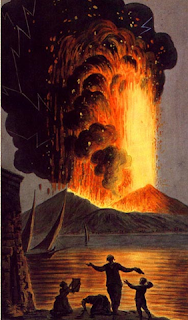Volcanic Eruptions and Hazards

What is a volcano?
- A volcano is a vent or 'chimney' that connects molten rock (magma) from within the Earth’s crust to the Earth's surface.
- The volcano includes the surrounding cone of erupted material.
How and why do volcanoes erupt?
- Hot, molten rock (magma) is buoyant (has a lower density than the surrounding rocks) and will rise up through the crust to erupt on the surface.
–
Same principle as hot air rising, e.g. how a hot
air balloon works
- When magma reaches the surface it depends on how easily it flows (viscosity) and the amount of gas (H2O, CO2, S) it has in it as to how it erupts.
- Large amounts of gas and a high viscosity (sticky) magma will form an explosive eruption!
–
Think about shaking a carbonated drink and then
releasing the cap.
- Small amounts of gas and (or) low viscosity (runny) magma will form an effusive eruption
–
Where the magma just trickles out of the volcano
(lava flow).
Explosive Eruptions
- Explosive volcanic eruptions can be catastrophic
- Erupt 10’s-1000’s km3 of magma
- Send ash clouds >25 km into the stratosphere
- Have severe environmental and climatic effects
- Hazardous!!!
Above: Large eruption column and ash cloud from an explosive
eruption at Mt Redoubt, Alaska
Explosive Eruptions
- Three products from an explosive eruption
–
Ash fall
–
Pyroclastic flow
–
Pyroclastic surge
Pyroclastic flows on Montserrat, buried the capital city.
Direct measurements of pyroclastic flows are extremely
dangerous!!!
Effusive Eruptions
- Effusive eruptions are characterised by outpourings of lava on to the ground.
Volcanic Hazards
- Pyroclastic flow
- Lahars/Mud flows
- Pyroclastic fall
- Lava flow
- Noxious Gas
- Earthquakes
Pyroclastic Flow
- For example, eruption of Vesuvius in 79 AD destroyed the city of Pompeii
Pompeii (79AD)
Pyroclastic Flow – burns
Pyroclastic Flow – lahars
- Hot volcanic activity can melt snow and ice
- Melt water picks up rock and debris
- Forms fast flowing, high energy torrents
- Destroys all in its path
So….
How do we minimize the risk of active volcanoes?
Volcano Monitoring
Volcano Observatories are set up on all active volcanoes
that threaten the human population. These are designed to monitor and
potentially to predict the eruptive behaviour of the volcano in question.
In Summary..
- Volcanoes are extremely hazardous.
- However, the volcano can be studied, monitored and understood.
- Each volcano is different, and offers a unique set of dangers
- Plans may be emplaced to help control potential damage.
if u like the post then give us the feed back in
below the comment box
any other information u need write us comment
and must like the fb page
thank u






















0 comments:
Post a Comment